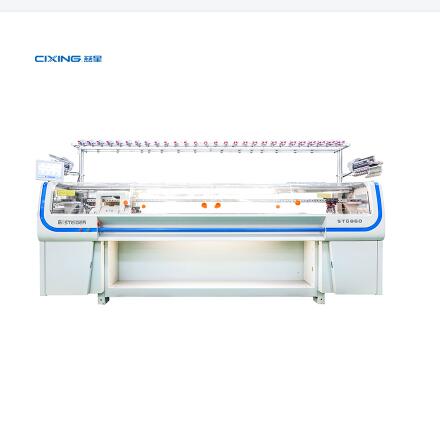Exploring Different Fabrics Produced by Flat Knitting Machines
2024-10-18
Flat knitting machines have become an essential tool in the textile industry due to their ability to create a wide range of fabrics with intricate patterns and varying textures. Whether for fashion, industrial use, or home textiles, the versatility of flat knitting machines allows for the production of high-quality fabrics that meet the demands of different markets. In this blog, we will explore the different types of fabrics produced by flat knitting machines, along with their characteristics and applications.

1. Rib Knits
One of the most commonly produced fabrics by flat knitting machines is rib knit. This fabric is characterized by its distinct vertical ribbed structure, which provides excellent elasticity and stretch. Rib knits are made by alternating knit and purl stitches in vertical columns, creating a fabric that has a high level of stretch and recovery.
- Characteristics: Rib knits are durable, flexible, and highly elastic. They retain their shape well and are often used in applications where stretch is required.
- Applications: Ribbed fabrics are commonly used for cuffs, collars, and hems in garments like sweaters, t-shirts, and jackets. They are also used for sportswear and undergarments due to their stretchability.
2. Jersey Fabric
Jersey fabric is another popular fabric produced by flat knitting machines. Known for its smooth surface and lightweight feel, jersey is created with a single needle bed on the machine, producing a single knit structure. This fabric can be made with a variety of yarns, from cotton and polyester to wool and silk, depending on the desired texture and application.
- Characteristics: Jersey fabric is soft, stretchy, and breathable. It has a smooth face on the front and a slightly textured surface on the back. Jersey knits are known for their comfort and flexibility.
- Applications: Due to its comfort and breathability, jersey is commonly used for t-shirts, dresses, and other casual wear. It is also used in bed linens and lightweight knitwear.
3. Interlock Knit
Interlock knit is a double-layered fabric produced by flat knitting machines, characterized by its smooth, thick, and sturdy construction. It is produced using two needle beds, where both sides of the fabric are knitted simultaneously, resulting in a fabric that has the same appearance on both sides.
- Characteristics: Interlock fabric is thicker and more stable than regular jersey knits. It is less stretchy than rib knits but offers better structure and strength. It also provides more warmth, making it ideal for cooler weather.
- Applications: Interlock knit is used for making thicker garments such as sweaters, sweatshirts, and jackets. It is also popular for baby clothes and activewear due to its durability and comfort.
4. Piqué Fabric
Piqué is a textured knit fabric with a distinct raised pattern or waffle-like appearance. Flat knitting machines can produce this fabric by varying the tension of stitches or creating special stitches that form the textured surface. Piqué fabric has a subtle texture, providing both visual and tactile appeal.
- Characteristics: Piqué is breathable, moisture-wicking, and has a soft feel with a slight texture. Its raised pattern enhances air circulation, making it a comfortable choice for warmer climates.
- Applications: Piqué fabric is often used in polo shirts, sportswear, and casual tops. Its breathable properties make it ideal for warm-weather clothing and athletic wear.
5. Jacquard Knit
Jacquard knit fabrics are created on flat knitting machines using advanced techniques that allow for complex patterns and designs to be knitted directly into the fabric. These patterns can range from geometric shapes and floral designs to intricate logos and images. The process involves controlling individual needles on the knitting machine to create multi-colored or textured patterns.
- Characteristics: Jacquard fabrics are highly customizable and visually striking, offering both texture and color variation. They can be lightweight or heavier depending on the type of yarn used and the complexity of the pattern.
- Applications: Jacquard knits are popular in fashion for creating unique and decorative garments, such as sweaters, dresses, and scarves. They are also used in home textiles like curtains and upholstery.
6. Terry Knit
Terry knit fabric, commonly referred to as French terry, is produced on flat knitting machines by creating loops on one or both sides of the fabric. These loops make the fabric soft, absorbent, and warm. The fabric can be produced in different weights depending on the density and height of the loops.
- Characteristics: Terry knit fabrics are highly absorbent, comfortable, and warm. The loops on the surface of the fabric can vary in size and density, providing different levels of softness and insulation.
- Applications: Terry knits are commonly used for towels, robes, loungewear, and casual sportswear. They are also ideal for baby clothes due to their soft texture and warmth.
7. Fully Fashioned Knit
Flat knitting machines have the unique capability of producing fully fashioned knits, where the shape of the garment is knitted directly into the fabric. This eliminates the need for cutting and sewing individual pieces together. Instead, the fabric is shaped during the knitting process, resulting in a seamless, well-fitted garment.
- Characteristics: Fully fashioned knits provide a smooth, clean finish without the need for seams. They are custom-shaped to fit the body, offering excellent comfort and a professional appearance.
- Applications: This type of knitting is used for high-quality knitwear, such as sweaters, cardigans, and tailored tops. The seamless nature of the fabric makes it ideal for luxury garments.
Conclusion
Flat knitting machines offer incredible versatility in producing a wide range of fabrics, each with unique properties and applications. From stretchy rib knits and lightweight jersey to textured piqué and decorative jacquard, these fabrics cater to various industries, including fashion, sportswear, home textiles, and industrial use. As technology advances, the possibilities for flat-knitted fabrics continue to expand, allowing for even more creativity and innovation in the textile world.
When selecting fabrics for specific projects, understanding the characteristics and benefits of different types of knits can ensure the best outcome in terms of comfort, performance, and aesthetics.


